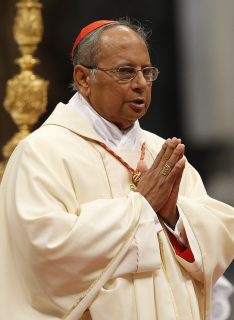
Cardinal Malcolm Ranjith of Colombo, Sri Lanka, is pictured in a file photo at the Vatican. The cardinal is seen by some as a possible contender to succeed Pope Francis, who died April 21, 2025, at age 88. (CNS photo/Paul Haring)
VATICAN CITY (CNS) — A former Vatican nuncio and collaborator in the Roman Curia, Sri Lankan Cardinal Albert Malcolm Ranjith, 77, has been leading the Archdiocese of Colombo since 2009.
Even though he only served as secretary of the former-Congregation for Divine Worship and the Discipline of the Sacraments for three-and-a-half years, it was during that time that Cardinal Ranjith became best known for his strong defense of tradition in the Catholic Mass.
He told the Vatican newspaper, L’Osservatore Romano, in 2007 that Pope Benedict XVI’s decision to give Catholics greater access to the pre-Vatican II Mass was a combination of growing requests for Mass in the old form, sometimes called the Tridentine Mass, and continued abuses of the new liturgy.
“The more this fidelity (and) a sense of the beauty and awe in the liturgy diminished, the more requests for the Tridentine Mass increased,” he said in the interview.
However, Cardinal Ranjith also expressed his support of postconciliar liturgical reforms, including the use of the vernacular, “the possibility of reception of Communion in the hand” and the priest facing the congregation.
In a lengthy commentary on liturgical reform published in 2004 in the Vatican newspaper, he said many of the past and current abuses in the liturgy arose from “an erroneous idea of the purpose of the council,” an opinion similar to one expressed by then-Cardinal Joseph Ratzinger in his book, “Salt of the Earth.”
The cardinal invited Pope Francis to visit Sri Lanka, which had been devastated by a 26-year civil war between government forces and Tamil Tiger rebels. The late pope visited in 2015, calling for “reconciliation, justice and peace” and canonized the country’s first saint, the 17th-century missionary priest Father Joseph Vaz.
All of the cardinal’s diplomatic and pastoral experience has been in Asia, with his longest stint being the head of his home archdiocese for the past 15 years.
The country is predominantly Buddhist with about 7.5% of the population being baptized Catholics, according to Vatican church statistics from 2023.
The nation has seen a rise in religious-based extremism. A shocking series of attacks occurred on Easter Sunday in 2019 when a group of suicide bombers affiliated with local Islamist group National Thowheed Jamath targeted three churches and three luxury hotels, killing at least 269 people, including 37 foreign nationals, and injuring at least 500.
Cardinal Ranjith concelebrated a Mass with about 10 bishops and thousands of faithful from Sri Lanka in St. Peter’s Basilica in 2022 to commemorate the massacre. A statue of Jesus, spattered with the blood of parishioners at one of the attacks, was placed near the altar.
He was an outspoken critic of the government’s flawed investigation and a strong supporter of transparency and justice, even urging the U.N. Human Rights Council to set up a mechanism to probe the Easter attacks.
Cardinal Ranjith also made urgent appeals for peace when violence broke out in the island nation in 2022 during a worsening political and economic crisis. “We must act nonviolently and not attack people” when expressing opposition, he said.
Born in northwestern Sri Lanka, Cardinal Ranjith was ordained to the priesthood in 1975. He completed his studies in theology at Rome’s Pontifical Urbanian University and did postgraduate studies at the Pontifical Biblical Institute in Rome.
He was named auxiliary bishop of Colombo, Sri Lanka’s capital, in 1991 and bishop of the newly erected Diocese of Ratnapura in 1995. In 2001, he returned to Rome to serve as head of the Pontifical Mission Societies under the Vatican’s then-Congregation for the Evangelization of Peoples.
In 2004, St. John Paul II named him an archbishop and apostolic nuncio to Indonesia and to East Timor. He was appointed secretary of the congregation for worship in 2005 and returned to Sri Lanka as archbishop of the capital city in 2009. Pope Benedict named him a cardinal in 2010.
PREVIOUS: Papal Ring, Insignia Destroyed at Cardinals’ Final Meeting
NEXT: Choose the Pope the World Needs, Dean Urges Cardinals Before Conclave



Share this story